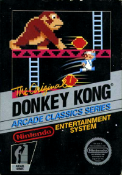I never loved the NES version because it only had 75% of the game, and I didn't like how the NES rendered the game's sounds. The best home version I saw was the Atari 8-bit version, which had all four levels and sounds that were much closer to the arcade than the NES version, despite decreased graphical fidelity compared to the NES version. The physics also felt rather "off" on the NES compared to the arcade or even the Atari 8-bit version.
Miyamoto designed DK under orders from Nintendo CEO Hiroshi Yamauchi to make a game geared towards Americans - originally, DK was going to be a Popeye-themed game, where Bluto would have filled the role occupied by DK. However, the actual coding was done by a company called Ikegami Tsushinki, who also manufactured the arcade boards. DK was a success, and Nintendo went ahead with a sequel. Unfortunately, Nintendo utilized Ikegami's code in making DK Junior without permission from Ikegami. Ikegami sued Nintendo, and it took the case almost ten years to work its way through the Japanese courts, after which they settled. However, Nintendo effectively lost the lawsuit, because the court acknowledged Ikegami's ownership of the code. Nintendo still had the copyright to its characters (though Mario Segale once joked that he was waiting for his royalties in one of the few interviews he ever gave), and since the code for the NES versions of DK and DK Junior was done by Nintendo itself, the NES versions are the versions they re-released. So other than what was likely an innocent mistake in not understanding still-nascent copyright and patent laws as they pertained to software, Nintendo wasn't really to blame for not releasing the arcade versions of those two games. Even the 3DS "ambassador" version was the NES version with the extra level added. I wonder if Nintendo was worried that tangling with Ikegami in court again might give Ikegami some kind of legal hold on Mario, which would have been very bad for Nintendo. That's not as far-fetched as you might think. Bandai Namco has been involved in a long-running lawsuit with AtGames over the code to Ms. Pac-Man, which is why we haven't seen her in the past few years.
With that said, you actually can get the arcade versions of DK, DK Junior, DK3, and Mario Bros legally on the Switch. They were all released as Arcade Archives titles by Hamster, with Mario Bros coming a few months after the Switch launched. DK came out in the summer of 2018, and DK Junior (the game which originally caused the Ikegami lawsuit) somewhat later that year. I'm guessing that Nintendo and Ikegami finally buried the hatchet and decided it wasn't worth fighting over, especially since Ikegami is no longer in the games business. The Arcade Archives version includes the original Japanese version, the revised Japanese version, and the US version. The US version is structured so that Level 1 only contains the barrel and rivet screens, Level 2 adds the elevator screen, and Level 3 adds the cement factory screen. Level 4 adds a second barrel screen between the cement factory and jack screens, and from level 5 onward, there is another barrel screen between the jack screen and the rivet screen, for a total of 6 screens. So the US version does better at upping the challenge for progression. To this day, Donkey Kong is my favorite arcade of all time, and it may possibly have been the first game I ever played. Its colors and the personality of the characters always captured my attention away from Pac-Man. My second favorite arcade game was Mario Bros, which also held the same allure as DK.
Nintendo regaining the rights to the arcade version of Donkey Kong even reflected itself in Super Smash Bros Ultimate. The music for the hammer now sounds like the arcade rather than the NES version, which was used for the first four generations of Smash, and the hammer now does the same effect when you hit someone with it that the arcade version does.















Comments